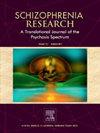Cell line specific alterations in genes associated with dopamine metabolism and signaling in midbrain dopaminergic neurons derived from 22q11.2 deletion carriers with elevated dopamine synthesis capacity
IF 3.6
2区 医学
Q1 PSYCHIATRY
引用次数: 0
Abstract
Microdeletions at the 22q11.2 locus are associated with increased risk for schizophrenia. Recent work has demonstrated that antipsychotic naïve 22q11.2 carriers display elevated levels of dopamine synthesis capacity (DSC) as assessed by 18F-DOPA PET imaging. While this is consistent with a role for abnormal dopamine function in schizophrenia, it is unclear what molecular changes may be associated with this neuro-imaging endophenotype, and moreover, if these alterations occur independently of clinical presentation. We therefore conducted a pilot study in which we generated human induced pluripotent stem cells (hiPSCs) from two 22q11.2 deletion carriers with elevated DSC in vivo, but distinct clinical presentations. From these and neurotypical control lines we were able to robustly generate midbrain dopaminergic neurons (mDA-neurons). We then assessed whether genes associated with dopamine synthesis, metabolism or signaling show altered expression between genotypes and further between the 22q11.2 deletion lines. Our data showed alterations in expression of genes associated with dopamine metabolism and signaling that differed between the two 22q11.2 hiPSC lines with distinct clinical presentations. This reinforces the importance of considering clinical, genetic and molecular information, when possible, when choosing which donors to generate hiPSCs from, to carry out mechanistic studies.
22q11.2 缺失携带者中脑多巴胺能神经元的多巴胺代谢和信号转导相关基因的细胞系特异性改变,这些携带者的多巴胺合成能力较强。
22q11.2 基因座的微缺失与精神分裂症风险的增加有关。最近的研究表明,通过 18F-DOPA PET 成像评估,抗精神病药物天真 22q11.2 基因携带者的多巴胺合成能力(DSC)水平升高。虽然这与多巴胺功能异常在精神分裂症中的作用一致,但目前还不清楚这种神经影像学终末表型可能与哪些分子变化有关,更不清楚这些变化是否与临床表现无关。因此,我们进行了一项试验性研究,从两个体内DSC升高但临床表现不同的22q11.2缺失携带者体内产生了人类诱导多能干细胞(hiPSCs)。从这些细胞系和神经典型对照细胞系中,我们能够稳健地生成中脑多巴胺能神经元(mDA-neurons)。然后,我们评估了与多巴胺合成、代谢或信号转导相关的基因在不同基因型之间以及进一步在 22q11.2 缺失系之间的表达是否发生了改变。我们的数据显示,与多巴胺代谢和信号转导相关的基因表达发生了改变,这在具有不同临床表现的两个 22q11.2 hiPSC 株系之间存在差异。这进一步说明,在选择供体生成 hiPSCs 以进行机理研究时,尽可能考虑临床、遗传和分子信息非常重要。
本文章由计算机程序翻译,如有差异,请以英文原文为准。
求助全文
约1分钟内获得全文
求助全文
来源期刊

Schizophrenia Research
医学-精神病学
CiteScore
7.50
自引率
8.90%
发文量
429
审稿时长
10.2 weeks
期刊介绍:
As official journal of the Schizophrenia International Research Society (SIRS) Schizophrenia Research is THE journal of choice for international researchers and clinicians to share their work with the global schizophrenia research community. More than 6000 institutes have online or print (or both) access to this journal - the largest specialist journal in the field, with the largest readership!
Schizophrenia Research''s time to first decision is as fast as 6 weeks and its publishing speed is as fast as 4 weeks until online publication (corrected proof/Article in Press) after acceptance and 14 weeks from acceptance until publication in a printed issue.
The journal publishes novel papers that really contribute to understanding the biology and treatment of schizophrenic disorders; Schizophrenia Research brings together biological, clinical and psychological research in order to stimulate the synthesis of findings from all disciplines involved in improving patient outcomes in schizophrenia.
 求助内容:
求助内容: 应助结果提醒方式:
应助结果提醒方式:


